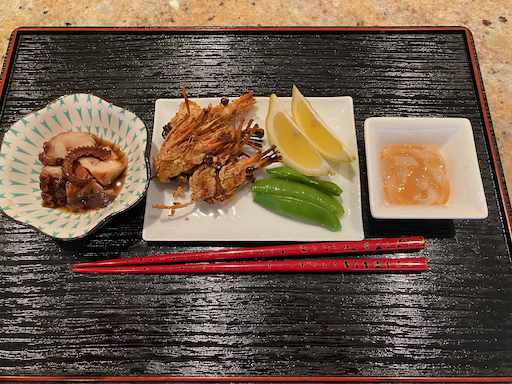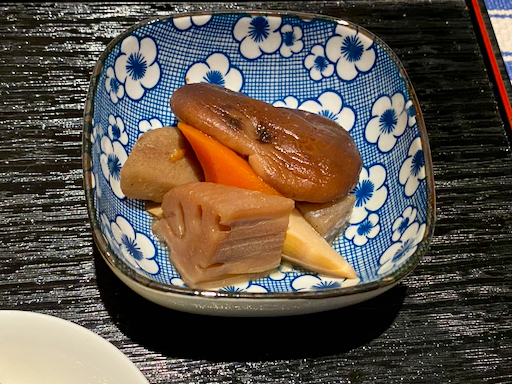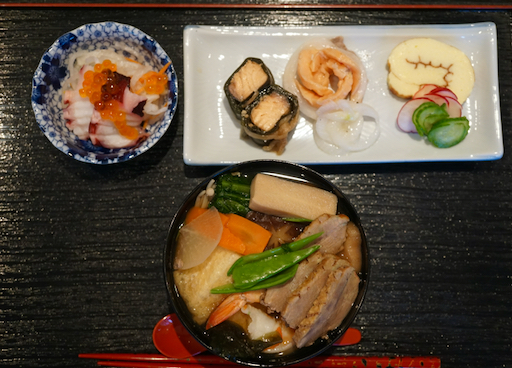Monday, August 7, 2023
Nine appetizers served in nine divided plate version 2
The top row left is blanched edible chrysanthemum or “shun-giku” 春菊 shown in detail below, dressed with x4 Japanese noodle sauce and mixed with generous amount of dried bonito flakes or “kezuri-bushi” 削り節. It has very distinct flavors which we really like.
The 1st row, middle is my ususal “dashi-maki” だし巻き Japanese omelet. This time I added dried green nori or “aonori” 青のり. I garnished it with julienne of green perila or “aoziso” 青紫蘇.
The next dish is a Chinese-style octopus salad or 中華風タコサラダ. It is pretty good and we like it.
The center row, left is hijiki seaweed, deep fried tofu and carrot stir fry or ひじきと油揚の炒め物.
The 2nd row center is one I just made this morning. Fried egg plant and mushroom simmered in broth or ナスと椎茸の揚げ浸し. The mushrooms include fresh shiitake and brown shimeji. This is served cold with garnish of blanched green beans.
The 2nd row left is my usual burdock root stir fry ゴボウのきんぴら.
The 3rd row left is a cold skinned Campari tomato. I cross cut the top halfway-through and poured on some Irizake 煎り酒 and special sushi vinegar (both from the Rice Factory). Irizake is boiled down sake seasoned with “umeboshi” picked plum 梅干し, kelp and bonito flakes. The sushi vinegar is a special kind from “Echizen 越前” or present day Fukui 福井. It tastes milder and better than our usual (Mizkan brand). I topped this with fine julienne of “Gari” がりsweet vinegar marinated thinly sliced ginger root (usually use to accompany sushi) and perilla. I got this idea from one of the food blogs I follow but I did not follow the recipe exactly.
The 3rd row center is store-bought fish cake which I heated up in the toaster oven and dressed in x4 Japanese noodle sauce and yuzukosho.
The 3rd row right is my usual “asazuke” 浅漬け picked (salted) vegetable which includes cucumber, carrot, nappa cabbage and daikon radish. I also added “shio konbu” 塩昆布, and ginger. The asazuke is about two weeks old but still tasted fresh (I attribute this to the fact I added a bit more salt - more than the usual 3% - and added a small amount of Vodka when I made it. While it didn’t alter the overall taste, I think this makes the asazuke last longer without becoming sour).
After enjoying these 9 small dishes both of us were quite full and did not eat anything else. All the wonderful different flavors and textures made a really enjoyable dinner.
Saturday, October 29, 2022
Tako rice and Matsutake soup for lunch タコ飯と松茸のお吸い物昼食
This was a lunch we had one day. We had leftover frozen octopus rice or “Tako meshi” たこめし made from a kit we got from the Rice factory. Although the original was not bad, the amount of octopus was rather small. Since I made tender simmered octopus タコの柔らか煮 a few days ago, I added slices of octopus legs to the previously made rice. Also we had matsutake mushroom 松茸 from Maine and made clear matsutake soup 松茸のお吸い物. I added a dish of salted vegetable or “asazule” 浅漬け and simmered root vegetables and chicken similar to “Chikuzen-ni” 筑前煮.
Monday, October 17, 2022
Octopus leg dressed in salted plum sauce タコの梅肉あえ
I have posted many dishes using octopus which we got from different sources. We like octopus legs (boiled and frozen) from D’artagnan and Great Alaska Seafood. Interestingly, both are “Spanish octopus legs”. The offer we recently purchased from Great Alaska Seafood included quite a large amount of octopus legs so I have the luxury of using it fairly regularly. The last time I used it, after thawing, I reserved about 2 inches of the octopus leg to eat as “sashimi*” 刺身 and I made the remainder into tender simmered octopus タコの柔らか煮 using an Instant pot. We usually eat octopus sashimi with wasabi and soy sauce or sumiso but this time, I tried a different dressing using salted plum or “Umeboshi” 梅干し (I used some umeboshi we received quite a few years ago from my mother the last time she made it. We kept it in a sealed container in the refrigerator. It looked and tasted good). I also served two small appetizer dishes.
*Most common “sashimi” of octopus is previously boiled legs because raw octopus is extremely perishable. Real “raw” octopus can be had in Japan. The first time we had “raw” octopus sashimi was in Kobe 神戸 many years ago. Because of the location of Kobe, very fresh octopus from the Japanese inland sea 瀬戸内海 was available. Now, because of the advancement in the logistics of transporting fresh seafood in Japan, it is more readily available throughout Japan. As a matter of fact, we had raw octopus sashimi at Tako Grill in Kuroishi 黒石, Aomori prefecture 青森県 in Japan.
Sunday, May 1, 2022
Octopus leg from D'artagnan ダルタニアンからのスペイン産タコの足
I am fond of octopus and I’m always on the look out for a good and reliable source. Our Japanese grocery store usually has it but I’m not going there as often as before. Our “tried and true” source is Catalina offshore products has frozen package of octopus for octopus leg from Japan. When I checked this time, however, only whole octopus was available. We tried several other sources but they are were not always reliable. We recently tried Great-Alaska seafood which sold "Boiled Spanish Octopus". This was not bad and came two legs in a package frozen so it is just the right amount; however, it is a bit too soft/mushy. I made "Yawaraka-ni" やわらか煮 or tender simmered octopus which worked really well. This time, while we were reordering duck breast and lamb loin from D'artagnan we found that they also sell frozen Spanish octopus legs and decide to give it a try. One evening, I thawed one leg and tried it with sumiso dressing (on the right in the picture below) along with some cold chawan-mushi 茶碗蒸し topped with ikura (shrimp, chicken and nameko mushroom are in the chawan-mushi).
Tuesday, March 1, 2022
Octopus and cucumber in sumiso dressing 蛸のぶつ切りと胡瓜の酢味噌あえ
This is nothing new; just a continuation of frozen and boiled Spanish octopus from Great Alaska Seafood. This is a good example of how an octopus leg cut can make a big difference in texture. Boiled octopus can be sliced thinly with a wave cut or cut into chunks called "Butsu-giri" ぶつ切り. The cut that is used depends on the firmness of the cooked octopus meat. Firm texture octopus it is quite chewy. A thick slice would be too difficult to eat. The thin wave cut provides a manageably chewy piece and the wave pattern catches any sauce that is used. Alternatively if the octopus meat is soft, the thinly slice wave cut doesn’t have any texture and basically dissolves when eaten so cutting it into chunks is the better choice. Since this octopus was a bit on the soft side, I opted for the chunky cut and made this classic "octopus and cucumber sumiso-ae" 蛸のぶつ切りと胡瓜の酢味噌あえ. I served this with store bought squid shio-kara (right)
Since this octopus leg was more tender than ones from Japan, this "Butsu-giri" cut really worked. It is not too chewy but has nice texture.
Saturday, February 26, 2022
Tender simmered octopus たこの柔らか煮
Ingredients:
Boiled octopus leg, thawed
200ml Japanese dashi (I made this from dashi pack).
1tbs soy sauce
2tbs mirin
2tbs sake
several think ginger slices
Directions:
I used an Instant pot with a small metal container insert with a silicon lid (you could use the inner pot of the instant pot).
I added the octopus and the seasoning liquid into the insert and put on the lid.
I added 1/2 cup water to the pot and using the metal holder that came with the insert, lowered it into the instant pot.
I cooked it on high pressure for 30 minutes with natural depressurization.
The picture below is after cooking.
One of the problems with the Instant Pot cooking is that the simmering liquid does not reduce at all.
So I decided to put the leg and the simmering liquid in a frying pan and cook it on medium flame for 15-20 minutes until the liquid reduced by half.
Sunday, January 30, 2022
Octopus rice 瀬戸内海蛸めし
We have been getting Japanese rice from the New York Rice factory. It may be hard to believe (we our selves are somewhat incredulous) that there could be such a difference in something as subtly flavored as rice but the rice from the rice factory is really good. It is hard to identify what sets it apart from the rice we used to get but in general we really like the texture, the taste and especially how well it can be reheated and still tastes like it just came out of the rice cooker.
Whenever I order rice from the rice factory I usually supplement the order with other items. In the past, we got a kit to make “red snapper rice” or “taimeshi” 鯛めし, a type of seasoned rice famous in the Japanese inland sea area or "seto-naikai" 瀬戸内海. Another time I ordered a similar seasoned rice kit made with octopus called “seto-naikai tako-meshi” 瀬戸内海蛸めし. After I bought it, however, the kit sat in our pantry for some time. When I checked the expiration date, it had expired the previous month, so I decide it was time to make it as a shime 〆 or ending dish one weekend. The kit came in several pouches; one with seasoning sauce, one with small bits of octopus, one with freeze dried items. It also included a rectangle of kelp. I made the octopus rice according to the instructions. I served it with a side of simmered Japanese root vegetables I had made and salted cucumber, daikon and nappa cabbage or "oshinko" お新香.
Wednesday, January 13, 2021
New year's eve sashimi 2020 年越しの刺身
For New Year's eve, we started with this sashimi. I ordered Atlantic tuna toro 鮪とろ, octopus leg 蛸, and ikura イクラ (all frozen) from Catalina offshore products at least a month ahead of time because last year I waited too long and when I got around to ordering sashimi for New Year they were sold out. I also got sashimi-grade salmon but it was a large piece and would have been too much so I did not thaw it. The toro piece was small (5oz) but enough for two of us. It contained "ootro" 大トロ and small portion of "chutoro" 中トロ. The octopus legs appeared to have been imported from Japan.
Friday, January 1, 2021
Happy New Year 2021 あけましておめでとう2021
The year 2020 was a quite taxing year. We hope things will get better in 2021, although we are, by no means, out of woods. Because of Covid, we stopped going to our Japanese grocery store (or many other stores for that matter). Having home delivery was a God-send. Nonetheless, however, we were not able to get all of our usual New Year food items or decorations including "Kagami-mochi" 鏡餅. (There may be a silver lining in this since we almost never eat all the small round mochi contained in it). So, this year our New Year's display was absent the Kagami-mochi. We only displayed the zodiac animal figurines representing the year--which in this case was the Ox. The pictures below show our collection of zodiac oxen. The smallest guy, in front, looks like a holstein cow and is made of painted wood. The one standing behind and looking at him is made from "do-rei" 土鈴 or earthenware and is actually a bell.
Thursday, March 19, 2020
Six "otoshi" appetizers お通し6種類
The upper row from left to right are Chinese-style squid salad (store-bought) with my sugar snap in salt broth, grilled fish cake (store bought) with blanched broccolini dressed in mustard soy sauce, Russian marinated salmon (leftover from the previous evening). (It had been marinading for 2 days by then). The lower row from left to right are octopus leg, cucumber slices and Campari tomato dressed in sumiso sauce and "mizuna" oshitashi 水菜のお浸しtopped with bonito flakes.
Although it missed the group picture, the sixth appetizer was; salmon sashimi and avocado cubes dressed in soy sauce, sesame oil, chiffonade of perilla and finely chopped garlic. The salmon was leftover from the prior evening. I made a slight modification by salting one side and searing it with a kitchen torch before cutting it into cubes. This added an additional grilled flavor and slight crusty texture.
The dish shown below is Chinese-style squid salad 中華風イカサラダ bought at our Japanese grocery store. The variation of this appears to be available at Catalina offshore products as well.
Below is a small deep fried fish cake which is almost always available at our Japanese grocery store. This appears to be locally made and is pretty good. We heat it up in the toaster oven. I dressed blanched broccolini florets with mustard soy sauce (I now make several Japanese sauces in small squeeze bottles and store them in the refrigerator for instant use).
This was leftover Russian marinaded salmon I made the night before. This marinaded a total of 2 days and was almost completely "chemically" cooked but the onion was better now (marinating just overnight, the sweet onion was a bit too raw). I topped this with salmon roe and garnished it with perilla.
The dish below came about due to a mistake I made. I thought I got a bunch of edible chrysanthemum 春菊 but instead it was Japanese mizuna 水菜. I blanched it very quickly for 20 seconds, drained and cooled it down by fanning and squeezed out the moisture (I did this in the morning and kept it in a Ziploc bag in the fridge.) I made this to "ohitashi" お浸し("hitasu" in Japanese is to "soak", I made the sauce with equal parts Japanese dashi and concentrated noodle sauce and "soaked" the mizuna) and topped it with bonito flakes. My wife preferred edible chrysanthemum but this was different and nice in its own right.
We still had the tip portion of the octopus leg left over. I just cut it up into small chunks and mixed the pieces with vinegared cucumber slices and quartered Campari tomato and dressed in sumiso (from the squeeze bottle I prepared earlier).
So with the help of store-bought and leftover items from the previous evening, I finally made a set of 6 appetizer to start the evening--mission accomplished!
Tuesday, March 10, 2020
Salmon sashimi three ways 鮭の刺身3種
The picture below shows straight salmon sashimi with my usual sugar snap in salted broth スナップ豌豆の塩びたし shown on the right.
The below is a new and very simple dish which I read about somewhere online. I just marinated the salmon sashimi in "shio ko-ji" 塩麹 for a few hours in the refrigerator. I served it topped with "ikura" salmon roe and garnished with chopped chives. The shio ko-ji made the salmon sashimi softer but added a bit slippery surface texture. This is certainly different and not bad but not our favorite way of serving salmon sashimi.
The picture below shows salmon cured overnight in Russian marinade 鮭のロシア漬け. Since the salmon is marinated only overnight, just the surface of the salmon pieces are chemically cooked but the center is still raw. This partial curing is possible because this is sashimi grade salmon. If I made this dish from regular salmon filet, I would make sure the center was opaque indicating that it was completely chemically cooked. I garnished this with a chiffonade of perilla leaves. We liked this preparation very much. To the left of the salmon is a salad of thinly sliced cucumber in sushi vinegar 胡瓜の酢の物 and sliced Campari tomato. On the right side is blanched broccolini dressed with mustard soy sauce.
Since we had boiled octopus leg from the Japanese grocery store, I served it with sumiso dressing as usual.
We really enjoyed this medley of salmon dishes but luckily there was still a small piece of salmon left to look forward to the next evening.


















































